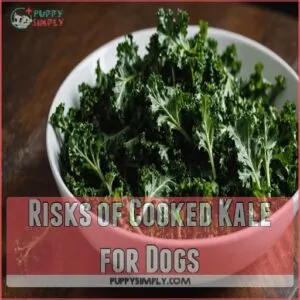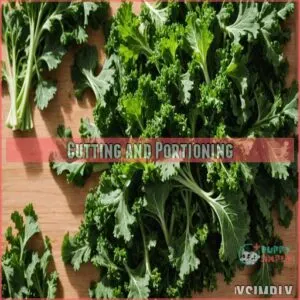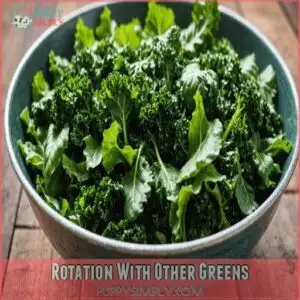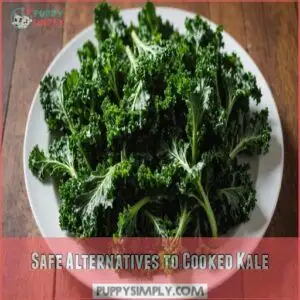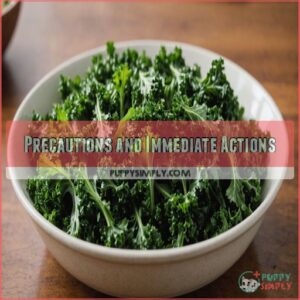This site is supported by our readers. We may earn a commission, at no cost to you, if you purchase through links.
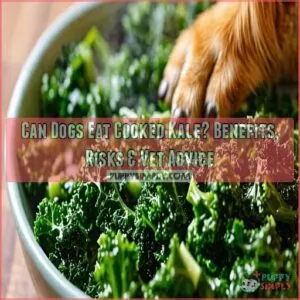 Yes, your dog can eat cooked kale safely when prepared correctly.
Yes, your dog can eat cooked kale safely when prepared correctly.
This nutrient-rich superfood packs vitamins A, K, and C, along with minerals that support your pup’s immune system.
You’ll want to steam or lightly boil the kale without seasoning, and cut it into small, manageable pieces.
Start with just a tablespoon mixed into their regular food once or twice a week.
While kale offers impressive health benefits, you’ll need to watch the portion size – too much can cause digestive upset or interfere with thyroid function.
The key is moderation and proper preparation, which makes all the difference in turning this leafy green into a healthy treat.
Table Of Contents
- Key Takeaways
- Benefits of Cooked Kale for Dogs
- Risks of Cooked Kale for Dogs
- Preparing Cooked Kale for Dogs
- Cooking Methods for Kale
- Serving Cooked Kale to Dogs
- Safe Alternatives to Cooked Kale
- Consultation With Veterinarians
- Precautions and Immediate Actions
- Frequently Asked Questions (FAQs)
- How much kale to feed your dog?
- How to cook kale for dog food?
- Why do dogs love kale?
- Is cooked kale digestible?
- How much kale can puppies safely eat?
- Can dogs with diabetes have cooked kale?
- Does kale interact with common dog medications?
- Will kale change the color of dog stool?
- Can dogs digest raw kale better than cooked?
- Conclusion
Key Takeaways
- You can safely feed your dog small amounts of cooked kale as an occasional treat, but moderation is crucial to avoid potential health risks.
- Properly prepare kale by steaming or lightly boiling it without seasoning, and cut it into small, manageable pieces before mixing it with your dog’s regular food.
- While kale offers nutritional benefits like vitamins A, K, and C, excessive consumption can lead to digestive issues, thyroid problems, or kidney complications in dogs.
- Always consult your veterinarian before introducing kale or any new food to your dog’s diet, especially if your pet has existing health conditions or is on medication.
Benefits of Cooked Kale for Dogs
Cooked kale offers your dog several nutritional benefits, including vitamins A and K which support their immune system and overall health.
It’s also a good source of fiber, which can aid digestion, but remember moderation is key!
Nutrient-Rich Antioxidant Benefits
Kale brings a nutrient-packed punch, offering antioxidant power that boosts your dog’s immune support.
It contributes to healthy skin, protects cells against damage, and aids vision benefits.
Kale can also support a shiny coat when combined with omega-3 rich foods.
When adding kale to your dog’s diet:
- Make sure dogs eat kale safely
- Rotate it with other greens
- Avoid overfeeding
These benefits make it an excellent choice when served in moderation.
Weight Loss Aid
Cooked kale can occasionally be a great ally in your dog’s weight management journey.
It’s low in calories yet rich in nutrients, making it a smart addition to a weight loss diet plan, which can be complemented by Low Calorie Dog Food.
Cooked vegetables like carrots or pumpkin, as part of a balanced diet that includes 10 human foods for dogs, can help fight dog obesity. Think of it as a healthy dog snack that helps fight dog obesity.
Remember, moderation is key, and always pair with regular exercise for best results.
Digestive Health Support
You might think kale’s just another leafy green, but it’s a secret weapon for your dog’s digestion.
Packed with fiber, it boosts gut health by aiding stool consistency and acting like prebiotics.
Here’s how cooked kale helps:
- Supports digestion by stimulating digestive enzymes.
- Promotes regular bowel movements.
- Improves nutrient absorption, adding value to your dog’s diet.
Risks of Cooked Kale for Dogs
While cooked kale might seem like a healthy treat for your dog, it’s important to know the risks.
Kale contains substances like thallium and goitrogens, which can affect your dog’s health.
If consumed in large amounts, kale can lead to kidney issues, thyroid problems, or gastrointestinal sensitivities.
Thallium Toxicity
While kale packs a nutrient punch, watch out for thallium toxicity in your dog.
This heavy metal can sneak in through the soil where kale’s grown.
Key thallium sources include vegetables grown in contaminated areas.
Symptoms like lethargy or vomiting signal trouble.
Treatment options focus on removing the source and managing symptoms.
Prevention strategies? Limit kale intake and diversify leafy greens.
Thyroid Impact
Feeding kale to your pup might mess with their thyroid due to goitrogens, which are sneaky compounds that:
- Interfere with iodine absorption
- Disrupt thyroid hormone production
- Affect dogs with hypothyroidism
- Contribute to iodine deficiency
- Potentially impact thyroid function
While kale has benefits, it’s important to balance it with other greens and consult your vet for safety.
Kidney Issues and G.I. Sensitivities
Kale’s goitrogens affect the thyroid, but it’s the calcium oxalate that’s a bigger worry for your pup’s kidneys.
Too much oxalate can lead to kidney stones and bladder stones.
Some dogs have sensitive stomachs and experience gastrointestinal upset.
If your dog has a history of kidney problems or digestive issues, skip the kale.
There are plenty of other yummy veggies out there!
Always chat with your vet before adding new foods to your dog’s diet.
Preparing Cooked Kale for Dogs
When preparing cooked kale for your dog, start by thoroughly washing and cleaning the leaves to remove any dirt and debris.
Then, choose a cooking method like steaming, boiling, or sautéing to soften the kale, making it easier for your dog to chew and digest without losing too many nutrients.
Washing and Cleaning
A dash of precaution goes a long way when washing kale for dogs.
Think dirt removal, pesticide residue, and safe handling.
You can use a kale wash to help make sure your kale is completely clean, especially if you’re concerned about pesticide residue.
Rinse kale under cold water, scrubbing gently to eliminate grime and pesticides.
Use a vegetable brush for stubborn spots, making sure thorough cleaning.
Consider organic kale to minimize pesticide exposure.
Make sure each leaf is pristine before serving.
Steaming and Boiling
After you’ve got that kale scrubbed clean, it’s time to get steaming or boiling.
These methods help keep nutrient retention high while changing the texture to make it easier for your furry friend to digest.
Just don’t overdo it; the cooking time should be short to avoid mush and maintain some flavor.
Always consider safety concerns, especially around nutrient loss and potential health impacts.
Sautéing and Cooking
Imagine you’re cooking for a picky eater—your pup.
For sautéing kale, you want to use a little safe oil like olive or coconut, and a non-stick pan.
Keep it simple, sauté for a few minutes until tender.
Skip the spices, though. Dogs appreciate flavor, but their taste buds aren’t into a spice party.
Cutting and Portioning
When cutting kale for your pup, remember size matters.
Chop it into small, bite-sized pieces to avoid any choking hazards.
A few leaves per serving size should do the trick, depending on your dog’s size.
To minimize risks, introduce kale gradually, watching for signs of gastrointestinal upset.
Rotate cooked kale with other greens, preventing potential health issues.
Aim for moderation—kale should be a treat, not a daily meal.
Cooking Methods for Kale
When you’re preparing kale for your dog, choosing the right cooking method is essential to retain nutrients and enhance flavor.
You can steam it for nutrient retention.
You can boil it to make it soft.
Or you can sauté it for a bit of extra flavor.
Steaming for Nutrient Retention
Steaming’s a great way to cook kale for your pup! It’s gentler than other methods, helping keep more nutrients, and can be part of a daily care routine that includes regular exercise and engaging activities like those found in a pet parents guide.
Aim for a steaming time of around 5-7 minutes, depending on your kale’s thickness. Over-steaming can lead to nutrient loss, so keep an eye on it.
Here’s what steaming does:
- Preserves vitamins.
- Keeps the kale’s vibrant color.
- Maintains a nice texture.
- Minimizes nutrient loss.
- A nice texture.
- Preserves vitamins.
- Keeps the kale’s vibrant color.
- Preserves vitamins.
- Keeps the kale’s vibrant color.
- Preserves vitamins.
- Keeps the kale’s vibrant color.
- Preserves vitamins.
- Keeps the kale’s vibrant color.
- Preserves vitamins.
- Keeps the kale’s vibrant color.
- Preserves vitamins.
- Keeps the kale’s vibrant color.
- Preserves vitamins.
- Keeps the kale’s vibrant color.
- Preserves vitamins.
- Keeps the kale’s vibrant color.
- Preserves vitamins.
- Keeps the kale’s vibrant color.
- Preserves vitamins.
- Keeps the kale’s vibrant color.
- Maintains a nice texture.
- Minimizes nutrient loss.
- A nice texture.
- Preserves vitamins.
- Keeps the kale’s vibrant color.
- Preserves vitamins.
- Keeps the kale’s vibrant color.
- Preserves vitamins.
- Keeps the kale’s vibrant color.
- Preserves vitamins.
- Keeps the kale’s vibrant color.
- Preserves vitamins.
- Keeps the kale’s vibrant color.
- Preserves vitamins.
- Keeps the kale’s vibrant color.
- Preserves vitamins.
- Keeps the kale’s vibrant color.
- Preserves vitamins.
- Keeps the kale’s vibrant color.
- Preserves vitamins.
- Keeps the kale’s vibrant color.
- Preserves vitamins.
- Keeps the kale’s vibrant color.
- Preserves vitamins.
- Keeps the kale’s vibrant color.
- Preserves vitamins.
- Keeps the kale’s vibrant color.
- Preserves vitamins.
- Keeps the kale’s vibrant color.
- Preserves vitamins.
- Keeps the kale’s vibrant color.
- Preserves vitamins.
- Keeps the kale’s vibrant color.
- Preserves vitamins.
- Keeps the kale’s vibrant color
Boiling for Softening
Boiling kale is a great way to soften those tough leaves for your pup.
Fill a pot with water, bring it to a rolling boil, and toss in the kale.
Let it simmer for about 5 minutes until it’s tender.
This method breaks down the fibers, making it easier for your dog to chew and digest.
Just remember, don’t go overboard – too much boiling can zap some nutrients.
Sautéing for Flavor
Sautéing kale can add a burst of flavor to your dog’s meal, but be cautious with ingredients.
Here’s how to do it safely:
- Use a small amount of dog-safe oil like coconut or olive oil
- Avoid garlic, onions, and excessive seasonings
- Cook until just wilted to preserve nutrients
- Let it cool before serving
Remember, moderation is key. While sautéed kale can be tasty, it should only be an occasional treat in your pup’s balanced diet.
Serving Cooked Kale to Dogs
When serving cooked kale to your dog, remember that moderation is key.
Mix small amounts with their regular food and rotate kale with other dog-safe greens to provide variety while minimizing potential risks.
Moderation is Key
Regarding serving cooked kale to your furry friend, less is more.
You’ve got the kale prepped, but don’t go overboard. Treat it like a fancy garnish, not the main course.
For most dogs, a tablespoon or two per week is plenty.
Remember, your pup’s size matters – a Chihuahua needs way less than a Great Dane.
Always start small and watch for any tummy troubles.
Mixing With Other Foods
Mix cooked kale into your pup’s regular chow for a nutrient boost.
You can sprinkle it over kibble or stir it into wet food.
Try pairing kale with lean proteins like chicken or fish for a balanced meal.
Get creative with dog-friendly kale recipes, using it as a topper or in homemade treats.
Remember, variety’s the spice of life – even for dogs!
Rotation With Other Greens
Don’t stop at kale when it comes to greens for your pup. Rotating different leafy veggies keeps things interesting and balances out potential risks. Switch it up with spinach, lettuce, or chard to give your dog a variety of nutrients. Remember, moderation is key – treat these greens as occasional snacks, not daily staples.
Here’s why rotating greens matters:
- Prevents nutrient imbalances
- Reduces risk of oxalate buildup
- Keeps mealtime exciting for your dog
- Helps you spot any food sensitivities
- Mimics a more natural, varied diet
Safe Alternatives to Cooked Kale
If you’re looking for safe alternatives to cooked kale for your dog, consider options like peas, green beans, spinach, and cucumbers.
These vegetables offer similar nutritional benefits without the potential risks associated with kale, ensuring your furry friend gets a varied and healthy diet.
Peas and Green Beans
Instead of kale, try peas and green beans for your pup.
These veggies are safe, nutritious alternatives that pack a punch without the risks.
Peas offer protein and fiber, while green beans are low-cal and rich in vitamins.
They’re easy to prepare too – just steam or boil ’em up.
Remember, moderation’s key. Mix a small handful into your dog’s regular food for a tail-wagging treat.
Spinach and Cucumbers
Spinach and cucumbers offer fantastic alternatives to kale for your pup.
Spinach packs a nutritional punch with iron and vitamins, but like kale, it contains oxalates.
Serve it sparingly.
Cucumbers are a hydrating, low-calorie treat that’s perfect for hot days.
They’re crunchy and invigorating, making them a hit with many dogs.
Remember to wash veggies thoroughly and cut them into bite-sized pieces to prevent choking hazards.
Other Leafy Greens
Looking beyond spinach and cucumbers, you’ve got plenty of other leafy greens to mix into your pup’s diet.
Romaine lettuce, collard greens, and Swiss chard are all safe bets.
These greens pack a nutrient punch without the risks associated with kale.
Remember, variety’s the spice of life – even for dogs!
Just like with any new food, introduce these greens slowly and watch for any tummy troubles.
Consultation With Veterinarians
You’ll want to consult your vet before adding cooked kale to your dog’s diet.
They can assess your pup’s health needs, considering factors like safe feeding practices for other vegetables like cooked cabbage benefits, and provide specific advice on safe serving sizes and frequency.
Recommendations for Feeding
Consulting a vet before feeding your dog cooked kale is a smart move.
They’ll help tailor recommendations to your pup’s unique needs.
If you’re looking for kale-infused dog food products, you can check online marketplaces like kale dog food.
Here’s what you might expect:
- Frequency: Once or twice a week as a treat
- Serving size: A few small leaves for most dogs
- Age considerations: Puppies may need less
- Breed-specific advice: Some breeds are more sensitive
Remember, every dog’s different.
Your vet can help you navigate kale’s benefits while avoiding potential pitfalls.
It’s all about finding the right balance for your furry friend.
Health Checks and Monitoring
When feeding your dog kale, keeping track of their health is essential.
Watch for these signs and schedule regular check-ups with your vet:
| Health Indicator | What to Monitor | Warning Signs | Action Needed |
|---|---|---|---|
| Digestion | Stool consistency | Diarrhea or constipation | Contact vet |
| Energy | Activity level | Lethargy or hyperactivity | Reduce portion |
| Appetite | Eating habits | Refusing food | Check thyroid |
| Weight | Monthly weigh-ins | Sudden changes | Adjust serving |
Your vet can help spot early warning signs and adjust portions as needed.
Dietary Changes and Adjustments
Most dietary changes need careful planning and monitoring.
Before adding kale to your dog’s menu, you’ll want to make gradual adjustments while watching for any reactions.
Here are three key steps:
- Start with tiny amounts mixed into regular food
- Monitor digestion and energy levels for 48 hours
- Slowly increase portions if no issues arise
Track your pup’s response in a food diary to share with your vet.
Precautions and Immediate Actions
When you’re feeding kale to your dog, you’ll need to watch for signs of digestive issues like vomiting or diarrhea that may require immediate veterinary care.
While kale is generally safe for dogs in moderation, you should also be mindful of pesticide residues and contamination risks that could affect your pet’s health.
Overfeeding and Digestive Issues
Despite kale’s healthy reputation, overfeeding can trigger digestive issues in your dog.
If you notice bloating, diarrhea, vomiting, constipation, or excessive gas after feeding kale, it’s important to identify the underlying cause, as chronic diarrhea can lead to dehydration, especially if it persists for more than 48 hours or is accompanied by vomiting, my dog has diarrhea but is acting fine.
Start with just a few small pieces mixed into their regular food once a week.
Your pup’s tummy will thank you for taking it slow and steady with this nutrient-rich veggie.
Pesticide Residues and Contamination
You’ll need to be extra careful with kale’s pesticide exposure, as it’s on the Environmental Working Group’s "Dirty Dozen" list.
Before feeding kale to your dog, thoroughly wash it under running water and pat it dry.
Better yet, opt for organic kale to minimize chemical residues.
If you’re using conventionally grown kale, a vinegar-water solution can help remove surface pesticides more effectively.
Emergency Veterinary Care
If you notice signs of kale poisoning in your dog, like vomiting or lethargy, don’t wait to see if symptoms improve.
Contact your emergency vet immediately, especially if your pup has existing kidney or thyroid issues.
Keep track of how much kale they’ve eaten and when symptoms started.
While waiting for care, don’t give any medication without veterinary advice, as it might cause harmful interactions.
Frequently Asked Questions (FAQs)
How much kale to feed your dog?
Feed your dog just a few cooked kale leaves once per week as a treat.
It’s best to rotate with other greens to prevent health risks.
Always start with small amounts to watch for reactions.
How to cook kale for dog food?
Steam or boil kale for 3-5 minutes until tender, removing tough stems first.
Let it cool completely.
Chop into small, bite-sized pieces.
Mix with your dog’s regular food once weekly as a nutritious treat.
Why do dogs love kale?
Dogs aren’t naturally drawn to kale – they’re more interested in its crunchy texture and the special attention you give while feeding it.
Your pup’s enthusiasm likely comes from positive associations with treats.
Is cooked kale digestible?
Cooked kale is easily digestible when you prepare it properly.
It’s best to steam or lightly boil the leaves, making them tender and easier for your furry friend’s digestive system to break down.
How much kale can puppies safely eat?
Puppies should eat kale sparingly.
Offer tiny amounts, no more than a small leaf once a week, as part of a balanced diet.
It’s best to consult your vet first, especially for growing pups.
Can dogs with diabetes have cooked kale?
Imagine this: your diabetic pooch eyeing that leafy green goodness.
You can offer cooked kale to dogs with diabetes, but in moderation.
It’s low in calories and carbs, potentially beneficial for blood sugar control.
Always consult your vet first.
Does kale interact with common dog medications?
Kale can interact with some medications your dog might be taking.
It’s best to check with your vet before adding kale to your pup’s diet, especially if they’re on thyroid or blood-thinning meds.
Will kale change the color of dog stool?
Yes, eating kale can change your dog’s stool color.
You might notice it becoming darker or even greenish.
Don’t worry, though – it’s usually harmless.
If you’re concerned, always check with your vet.
Can dogs digest raw kale better than cooked?
While it’s tempting to think raw is always better, cooked kale is actually easier for dogs to digest.
The cooking process breaks down tough fibers, making nutrients more accessible.
You’ll want to stick with cooked kale for your pup.
Conclusion
Like Icarus flying too close to the sun, feeding your dog too much cooked kale can lead to unexpected consequences.
While this nutrient-packed green offers health benefits, moderation is key.
Properly prepared, cooked kale can be a safe, occasional treat for your pup.
Remember to consult your vet before making significant changes to your dog’s diet.
By following the guidelines we’ve discussed, and considering safe foods like apples, broccoli, and green beans that are part of the ultimate guide to what huskies can and cant eat, you can confidently answer the question, "Can dogs eat cooked kale?" with a cautious yes, enhancing your furry friend’s diet responsibly.


